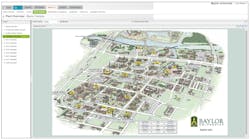Cool cash: Optimized chillers deliver ROI at Baylor University
By ERIC TOBACK, PE, LEED AP
Optimum Energy, New York, NY
Baylor University, a private college in Waco, Texas, had a typical chiller plant — it ran well, but it was also a hodgepodge of equipment. The only major problem was that the plant was managed manually.
Kenneth Haltom leads Baylor’s energy services team, in partnership with Aramark. Suspecting that chiller plant optimization would be the best way to increase efficiency and reduce related costs, they brought in Optimum Energy to assess the opportunity — and found that their hypothesis was right. Within the first year of installing Optimum’s OptimumLOOP™ software and the OptiCx™ platform, Baylor saved more than $460,000 in electricity costs. Demand for chilled water decreased across the campus and its air-conditioned spaces became more comfortable. The solution proved to be even more flexible than Haltom had expected.
Challenge: Automating a heterogeneous plant
Prior to optimization, plant operators judged when to add or shed load based on demand. Their criteria were sound, but unfortunately they acted on critical decisions — such as shifting a building’s temperature or starting or stopping equipment — only once per shift. Human error made the plant even more inefficient. For example, operators could interpret criteria differently, resulting in inconsistent system adjustments.
Within the first year of installing new software on a new platform, the University had saved more than $460,000 in electricity costs.
One thing standing in the way of chiller automation was complex hydraulics. The plant equipment varies widely — some of the eight chillers are 18 years old, while others are only a year old. Three have variable-speed drives, two have dual compressors, and each has different pressure drop and design flow. A fixed-valve solution to balance water flow between chillers was out of the question.
“We had to get the machines that don’t have variable-speed drives to work correctly with those that do, making sure the machines wouldn’t overflow, but we’d still get an efficient flow out of each of them,” said Haltom.
Solution: Finding the ideal balance points
Optimum Energy’s OptimumLOOP is a closed-loop solution that reads data every 30 seconds and dynamically adjusts the chiller plant equipment in real time, in response to changing conditions. The company’s engineers had to find the balance point for each chiller, whether it was running concurrently with the others or individually. To do this with a valve table would have meant determining the ideal valve sequence — out of a possible 256 run combinations — that would enable the chillers to maintain appropriate water flows while operating as efficiently as possible. Since that was not a plausible approach, OptimumLOOP dynamically adjusts the control valves on all running chillers to maintain an equal percentage flow on each.
The solution uses proprietary algorithms, but as with all plants, Baylor’s combination of fixed- and variable-speed equipment required some customization to fit requirements. But since variable-speed drives were already installed on all pumps and cooling towers, installing the solution didn’t require any mechanical changes.
Now the software automatically determines the best operating conditions across the plant and makes on-the-fly changes to all of the chillers, as well as the nine primary chilled water pumps, 11 condenser water pumps, and 13 cooling towers.
“OptimumLOOP made everything automatic, from slightly adjusting a single valve to improve water flow, to shedding entire machines from the system when demand decreases,” explained Haltom. “Each of the eight chillers operates at a different output and rate, depending on what gives us the greatest efficiency.”
Result: Saving money, energy, and carbon emissions
OptimumLOOP is saving Baylor more than $460,000 a year (about 24 percent of electricity costs) and dramatically shrinking energy consumption. The university has also saved an average 5.8 million kilowatt-hours and 8.6 million pounds of CO2 per year.
“The product from the chiller plant is better, more consistent, and it’s now based on real-time load rather than operator guesses,” said Haltom. “Dynamically adjusting the chillers in real time has made a big difference in energy consumption.”
Also important to Haltom is how easy it is to maintain the chiller equipment. Staff can simply remove a component from the OptimumLOOP list, and after they’ve cleaned or repaired that item and restored it to the list, the component automatically goes back online. Optimum’s OptiCx platform allows the facilities team to dive into plant operations down to the equipment level. Now they can easily see what chillers are operating and when the next chiller will be added or shed, and compare building chilled water differential pressures throughout the campus.
“Chiller optimization offered us the biggest bang for the buck when Baylor explored ways to reduce its energy spend,” said Haltom. “Optimum Energy is top notch—their engineers really understand the chiller equipment, and OptimumLOOP works very well, is flexible, and integrates seamlessly with our Siemens building automation system.”
Based in New York City, the author is director of project development at Seattle-based Optimum Energy. Contact him at [email protected] or 917-512-2242.




